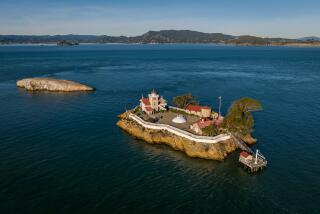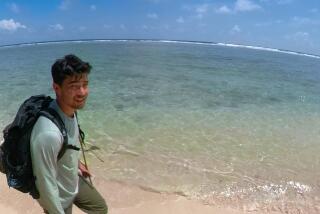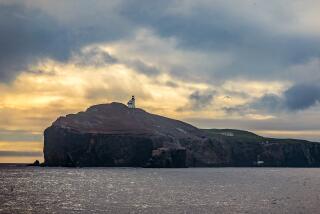The rock stars of Easter Island
Reporting from Hanga Roa, Easter Island — As our tour group gazes at the view from the slopes of Rano Kau — one of three extinct volcanic peaks on Easter Island — an explosion sounds in the valley below, followed by a puff of white smoke. “Don’t worry, that’s normal,” our guide, Tom, says. “Well, normal dynamite.” The blast, he explains, is caused by crews breaking up rocks for a construction project on the outskirts of Hanga Roa, the island’s only town.
Easter Island has seen an enormous boost in development in the last few years as tourists flock to this remote but beautiful outpost in the South Pacific Ocean. July 2010 saw the greatest influx of tourists in the island’s history, as thousands — myself included — came from around the world to witness a total solar eclipse under the watchful eyes of the moai, the enigmatic giant carved stone heads that dot the island. (The eclipse was a rare treat; the next total eclipse visible from the island won’t happen for more than 300 years.)
Despite the recent growth, Easter Island — Isla de Pascua in Spanish, Rapa Nui to the native Polynesian population — is still a place of exquisite solitude. It is, by some accounts, the most remote inhabited place in the world. Getting there usually means a 14-hour flight from Los Angeles to Santiago, Chile, followed by a five-hour flight to the island. For most of that last leg, you see only ocean. The nearest populated island is Pitcairn, more than 1,200 miles to the west, while the Chilean mainland lies 2,300 miles to the east.
It’s no wonder that for most of human history, this little spot of land was unknown. The first settlers arrived about 900, traveling by canoe from what is now French Polynesia. The first contact with Europeans occurred on Easter 1722, when a Dutch expedition under Jacob Roggeveen made landfall.
Roggeveen, like today’s visitors, was mesmerized by the island’s remarkable ancient culture, especially the moai. He was “struck with astonishment” at the sophistication of the statues and was puzzled as to how they could have been transported: “We could not comprehend how it was possible that these people, who are devoid of heavy thick timber for making any machines, as well as strong ropes, nevertheless had been able to erect such images, which were fully 30 feet high, and thick in proportion.”
The islanders already were suffering: Inter-tribal warfare had taken its toll, the island was almost completely deforested and many moai had been toppled. When Capt. James Cook visited in 1774, he described the locals as “small, lean, timid and miserable.” By the late 1800s, all moai had been toppled; the ones that greet visitors today have all been reerected.
I encountered my first moai at the remarkable Ahu Tahai complex, nestled against a wall of low cliffs at the ocean’s edge north of Hanga Roa. The complex consists of three sets of moai (each grouping on its own ahu, or platform), including a row of five moai at the southern end of the site, in varying degrees of preservation.
The moai, you quickly discover, are everywhere: There are nearly 900 of them scattered about the island, ranging from 6 1/2 to 30 feet tall; the largest is estimated to weigh 270 tons. Most are believed to have been carved at the Rano Raraku quarry, near the island’s eastern tip; today visitors can see dozens of moai, in various stages of completion, strewn around the grassy slopes of the quarry and the adjacent crater. Archaeologists believe that both lumber and rope would have been required to move them, which would explain the early deforestation of the island.
But what drove the ancient Rapa Nui to build the moai in the first place? They were likely objects of devotion, part of a religious tradition that may have evolved into something of an obsession. The increasing size of the statues over the years “suggests competition between rival chiefs, commissioning the statues to outdo each other,” writes Jared Diamond, who discusses the rise and fall of the Easter Island culture in his book “Collapse.” The statues were likely “produced as a show of one-upmanship.”
Today, the most spectacular moai site is Ahu Tongariki, the majestic row of 15 statues on the northeast corner of the island. A few miles to the west is Ahu Nau Nau, near the midpoint of the north coast and close to the island’s only sandy beach. The moai at Nau Nau are distinguished by their reddish, cylindrical pukao, or topknots. Archaeologists believe the topknots were a late development, added to some of the moai many years after the statues were erected. No doubt the topknot was, at one time, the height of Rapa Nui fashion.
To my mind, the island’s most compelling site is Ahu Akivi, inland about four miles northeast of Hanga Roa. It’s the only moai site away from the ocean and the only one in which the statues face the sea. The ahu supports seven rather thin but remarkably well preserved moai, lost in silent contemplation.
From Ahu Akivi, near the island’s geographic center, you can see perhaps half of the island, which stretches a little more than nine milesacross at its widest point and has an area of about 60 square miles — about twice the size of Manhattan. The landscape is mostly flat, with a few rolling hills; the three highest peaks are found near each corner of the triangular-shaped island. (Today, there are some forested areas, but they consist of nonindigenous species, such as eucalyptus, introduced in modern times.)
Because nearly all of the island’s 4,500 inhabitants live in Hanga Roa, the countryside itself can seem deceptively empty, especially if you reach your preferred moai site ahead of the tour buses. The town itself, meanwhile, is slightly busier, with the main street lined with cafes and taverns. Corner stores stock groceries and other essentials for the islanders, and souvenirs for the tourists; kids play soccer in just about any open field. There is one post office and one ATM (though at least two Internet cafes, as I later discovered). More than once I saw islanders galloping through town on horseback.
The population of the island, annexed by Chile in 1888, is today about a 60-40 mix of Polynesian and Chilean. Spanish is the official language, though Rapa Nui (the indigenous language) and English can be heard in equal measure in the streets.
Tourism, of course, is the lifeblood of Easter Island, yet there are concerns about just how many visitors the island’s delicate archeological treasures can handle. Many indigenous Rapa Nui believe their way of life is at risk and are pushing for more control over the way the island is run. Some believe that Chile has excluded them from the decision-making process and from the profits flowing from the tourism industry. Just a few weeks after my visit, tensions flared up over a planned $50-million hotel project in Hanga Roa. Members of a local clan, who claim the hotel grounds as part of their ancestral lands, staged a series of sit-ins until forced to leave by Chilean police earlier this year.
Our hotel manager, Edgar, acknowledged the tension between the two cultures. He too relies on tourists for his livelihood yet wonders how many is too many. Whatever happens, he will be here to witness it. As a descendant of the original Rapa Nui settlers — I take him at his word on this — he has always called the island home. “Why would I leave?” he asks. “It’s paradise.”
More to Read
Sign up for The Wild
We’ll help you find the best places to hike, bike and run, as well as the perfect silent spots for meditation and yoga.
You may occasionally receive promotional content from the Los Angeles Times.






